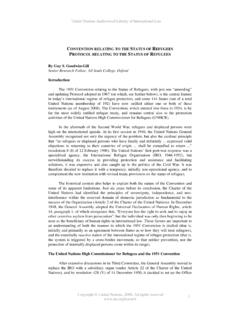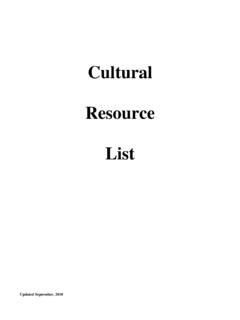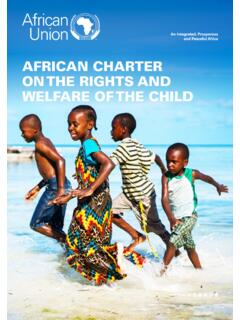Transcription of Refugee Children: Guidelines on Protection and Care
1 Refugee children : Guidelines on Protection and CarePrefaceUsually more than half of any Refugee population are children . Refugee children are children first andforemost, and as children , they need special attention. As refugees , they are particularly at risk with theuncertainty and unprecedented upheavals which are increasingly marking the post-Cold War order to improve and enhance the Protection and care of Refugee children , UNHCR has adopted aPolicy on Refugee children , endorsed by the UNHCR Executive Committee in October 1993. TheUNHCR Guidelines on Refugee children , first published in 1988, have been updated in the light of thenew Policy and are presented in this document.
2 At their core lies the realization of the need whichchildren have for special care and are vulnerable. They are susceptible to disease, malnutrition and physical are dependent. They need the support of adults, not only for physical survival, particularly in theearly years of childhood, but also for their psychological and social are developing. They grow in developmental sequences, like a tower of bricks, each layerdepending on the one below it. Serious delays interrupting these sequences can severely children face far greater dangers to their safety and well being than the average child. Thesudden and violent onset of emergencies, the disruption of families and community structures as well asthe acute shortage of resources with which most refugees are confronted, deeply affect the physical andpsychological well being of Refugee children .
3 It is a sad fact that infants and young children are often theearliest and most frequent victims of violence, disease and malnutrition which accompany populationdisplacement and Refugee outflows. In the aftermath of emergencies and in the search for solutions, theseparation of families and familiar structures continue to affect adversely Refugee children of all , helping Refugee children to meet their physical and social needs often means providing support totheir families and are the concerns reflected in the Guidelines , which define the goals and objectives, the principlesand practical measures for the Protection and assistance of Refugee children .
4 By placing children in thecontext of the family and the community, the Guidelines focus attention on the children 's developmentalneeds, their gender and cultural framework, the special requirements of unaccompanied minors, and theparticular problems which arise in the context of repatriation and process of producing these Guidelines has been an encouraging one for UNHCR. NGOs and UNsister agencies have contributed generously and enthusiastically to the document as have UNHCR staffin the field and at Headquarters. While the Guidelines are primarily intended as directives for UNHCR staff, enhancing their capacity to promote and design programmes which are responsive to the rightsand psychological and material needs of Refugee children , I hope that our partners will also find theGuidelines useful in developing their own programmes and ultimate value of the UNHCR Policy and Guidelines on Refugee children will lie in stheir translationfrom words to concrete action.
5 Just as the development of these Guidelines has been a cooperativeeffort, I hope that in their implementation we can also count on the full support of all concerned. I wouldlike to invite UNHCR staff and government representatives, UN organizations and NGOs to join forces,as well as their skills and resources, in making a positive difference on the lives of Refugee OgataUnited Nations High Commissioner for RefugeesChapter 1: IntroductionI. Who this book is for and how to use itThis book was written with several groups in mind. It is primarily for UNHCR's staff, but it is also for thestaff of its operational partners, whether they be voluntary organizations, UN agencies or chapter takes a subject, such as Legal Status or Psychosocial Well-being, and discusses it fromthe point of view of children 's needs and rights.
6 Generalists working in the field will be able to gain anoverview of a subject as well as guidance for addressing specific the end of each main chapter, there is a check-list. It contains the essence of the Guidelines in thechapter and can be used as a quick means of evaluating whether a field office has taken appropriatemeasures to ensure that the Protection needs of children are met and that appropriate care is is a "More Reading" section at the end of each chapter for those who want additional and other specialists, both in the field and at headquarters, should also find the book usefulbecause the Guide lines emphasize links - links between children , their family and their community, andlinks between different aspects of a child's life.
7 Such as education and psychosocial well-being. Bykeeping these connections in mind we can increase the benefits of our work and reduce unintendedconsequences. In addition, setting priorities involves focusing more on one aspect than on another, andthis requires keeping a broader picture - all the links - in most of UNHCR's work is done through operational partners, the Guidelines will assist in unifyingall our efforts towards a common goal: the Protection and care of Refugee book was also written with Governments in mind. These Guidelines will help countries of origin andcountries of asylum to understand what UNHCR is trying to do for Refugee children and why, and willtherefore serve as a solid basis for cooperation.
8 Furthermore, the Guidelines will be a starting point fordialogue with the UNHCR Executive Committee and donor States on Refugee children : What are theproblems in implementing the Guidelines ? What else needs to be done? By whom? How?II. What these Guidelines are and what they are notThis book is not a practice manual. Unlike the manual you may get when you buy a car, this book willnot tell you how to fix something when it is broken or how to keep it from getting broken; it will not tellyou, "In situation X, you must do Y".By contrast, Guidelines help you solve problems by pointing out things that are important for you to keepin mind.
9 In using Guidelines you must always rely on your knowledge of the local situation, your skills,and your common sense to get the job done. For example, in the chapter on Psychosocial Well-beingwe say, "The single best way to promote the well being of children is to support their family," and thenas one of the Guidelines on how to support families there is a paragraph on extra help to single-parentfamilies. We explain why this is important. These Guidelines do not give instructions on how to set upand run a programme to support single parents, but we want every reader of this book to know why suchsupport may be important.
10 Once you have this information, then we can ask you to use your knowledgeof the local situation, your skills and your own best judgment to take whatever action you can to qualification needs to be made. Guidelines are not mere suggestions that can be ignored when it isnot convenient to follow them. Guidelines are tools for reaching policy objectives, so there must be goodreasons for not following them in a specific situation. Sometimes you will find a statement that is morestrongly worded than other Guidelines . In such cases, that particular guideline is a set standard ofpractice that must be followed, except under the most extraordinary of the Guidelines are also "universal"; they apply in an emergency situation as well as in on-goingrefugee assistance programmes, both in countries of asylum and in countries of return.












